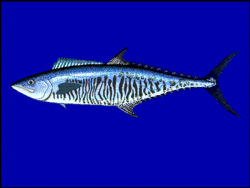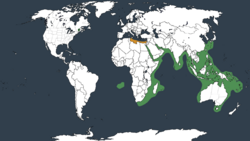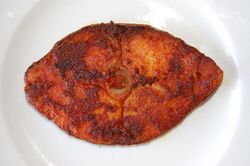Biology:Narrow-barred Spanish mackerel
| Narrow-barred Spanish mackerel | |
|---|---|

| |
| Scientific classification | |
| Domain: | Eukaryota |
| Kingdom: | Animalia |
| Phylum: | Chordata |
| Class: | Actinopterygii |
| Order: | Scombriformes |
| Family: | Scombridae |
| Genus: | Scomberomorus |
| Species: | S. commerson
|
| Binomial name | |
| Scomberomorus commerson (Lacépède, 1800)
| |

| |
| Synonyms | |
| |
The narrow-barred Spanish mackerel (Scomberomorus commerson) is a mackerel of the family Scombridae found in a wide-ranging area in Southeast Asia, but as far west as the east coast of Africa and from the Middle East and along the northern coastal areas of the Indian Ocean, and as far east as the South West Pacific Ocean.[3]
Description
They are vivid blue to dark grey in colour along their backs and flanks and fade to a silvery blue-grey on the belly. Spanish mackerel have scores of narrow, vertical lines down their sides. Spanish mackerel grow to about 200 cm and up to 70 kg.[3] They are the largest of all Australian mackerels.[citation needed]
Distribution and habitat
Scomberomorus commerson is found in a wide area centering in Southeast Asia, but as far west as the east coast of Africa and from the Persian Gulf and along the northern coastal areas of the Indian Ocean, and as far east as Fiji in the South West Pacific ocean. The species is common down both sides of Australia as far south as Perth on the west coast and Sydney on the east coast. It is also found as far north as China and even Japan.[3][4] Recorded first in the Mediterranean Sea in 1935 off Mandatory Palestine, it is now very common in the eastern Levant where it has become an important target species for local fisheries.[5]
Life cycle
Spanish mackerel spawn in oceanic conditions on reef edges. Eggs have a large oil droplet that aids in buoyancy and keeps them at the top of the water column which is warmer, well oxygenated, and has an abundant planktonic food supply for the larvae once they are hatched. When in the larval stage, Spanish mackerel are believed to stay in their own species-specific groups and are not normally found with other species of the same genus, such as S. semifasciatus and S. queenslandicus. This is not always the case with adult mackerel, where occasional mixing of different species within the same genus can occur.
Spawning is seasonal, but it is protracted in the warmer waters of the tropics. Many of the fisheries that target this species are based on prespawning feeding aggregations. A significant proportion of the female fish caught in NT waters between July and December have either recently spawned or are close to spawning.[6] In general, spawning times for Spanish mackerel tend to be associated with higher water temperatures that promote optimal food availability for the rapid growth and development of the larvae.[7]
As the young larvae grow, they move from the offshore spawning grounds to inshore and estuarine habitats, where they are frequently found in the juvenile phase of their growth cycle. In the inshore environments, they feed mostly on the larvae and juveniles of small fish and crustaceans until they become large enough to eat small fish and squid.[8] Australian studies of this species suggest females are larger than males.[9][10][11] Female Spanish mackerel mature at about two years of age or around 80 cm in length.[12]
Feeding habits
Spanish mackerel are voracious, opportunistic carnivores. As with other members of the genus, food consists mainly of small fishes with lesser quantities of shrimp and squid.
Fisheries, fishing gear and methods
Spanish mackerel are highly valued fish throughout their range in the Indo-West Pacific. Recreational anglers catch them from boats while trolling or drifting and from boats, piers, jetties, and beaches by casting spoons and jigs, and live-bait fishing. Commercial methods are primarily run-around gill netting, and rarely, by trolling lures similar to those used by recreational anglers.[3]
Australia
As of July 2023, the Government of Queensland, Australia , cut the commercial catch limit from 578 tonnes (569 long tons; 637 short tons) to 165 tonnes (162 long tons; 182 short tons), a reduction to 27.5% of the earlier limit. The split was: 60% commercial; 40% recreational (1/person) but also includes charter boat fishing; Indigenous 2 tonnes/year limit across all allocations. This is intended to revitalise of the biomass over time.[13]
Taiwan
In Penghu, Taiwan the narrow-barred Spanish mackerel is highly valued and referred to as "white gold."[14] In 2022 an exceptional 34 kilo fish was sold for more than $3,000.[15] In Tainan it is used to make the dish tutuo yugeng (土魠魚羹, Spanish Mackerel thick soup).[14]
Aquaculture
In 2023 the Taiwanese Fisheries Research Institute succeeded in artificially breeding narrow-barred Spanish mackerel.[16]
Parasites
As with most fish, the narrow-barred Spanish mackerel is infected by a variety of parasites. Spectacular parasites are the cysts of the larvae of the trypanorhynch cestode Callitetrarhynchus gracilis, often found in great numbers in the body cavity.[17]
Common names
- Pakistan: Surmei سرمٸ
- South Africa: king mackerel, couta, cuda
- Malaysia: tenggiri
- Australia: narrow-bar, narrow-barred mackerel, snook, Spaniard, Spanish mackerel
- USA: barred mackerel, narrow-barred mackerel, striped seer
- Arabic: In Lebanon, it is called "abu sinn ابو سن" or"ghazal غزال", in Egypt 's Mediterranean and the Red Sea it is "Dirak ديرك", while on the shores of the Persian Gulf it is kanaad, kanad or kana'd كنعد pronounced ‘Chanaad’, according to the local dialect inflection, despite the sound ‘ch’ not existing in the Arabic language.
- India: konem in Telugu, vanjaram in Tamil, anjal in Tulu, Shermai in Dhakhani Urdu,Surmai In Marathi , "Neymeen" "Aykoora" in Malayalam
- Iran: shir mahi شیرماهی
- Israel: Palamida (פלמידה), Squmbren zariz (סקומברן זריז, meaning quick Spanish mackerel)
- Philippines: tanigue
- Indonesia: ikan tenggiri
- Sri Lanka: Thora in Sinhalese, vanjaram in Tamil
- Somalia: Yuumbi
- Fiji: walu
- Thailand: plā xinthrī (ปลาอินทรี)
- Libyan: yamaneyah يمنيه.
- Taiwan: 土魠魚, "thô͘-thoh-hî", "tǔtuōyú"
- Dutch: koningsvis[14]
- South China: majia (馬加魚)[14]
References
- ↑ Collette, B.; Chang, S.-K.; Di Natale, A.; Fox, W.; Juan Jorda, M.; Miyabe, N.; Nelson, R. (2011). "Scomberomorus commerson". IUCN Red List of Threatened Species 2011: e.T170316A6745396. doi:10.2305/IUCN.UK.2011-2.RLTS.T170316A6745396.en. https://www.iucnredlist.org/species/170316/6745396. Retrieved 19 November 2021.
- ↑ Collette, B.B.; Smith-Vaniz, W.F.; Hartmann, S.; Bishop, J.; Alam, S.; Al-Khalaf, K.; Alghawzi, Q.; Abdulqader, E. et al. (2015). "Scomberomorus commerson (Persian Gulf assessment)". IUCN Red List of Threatened Species 2015: e.T170316A57242652. https://www.iucnredlist.org/species/170316/57242652. Retrieved 3 December 2023.
- ↑ 3.0 3.1 3.2 3.3 Froese, Rainer and Pauly, Daniel, eds. (2018). "Scomberomorus commerson" in FishBase. April 2018 version.
- ↑ "Fishnet | the Fish Files". http://www.fishnet.com.au/default.aspx?id=225&fishid=101.
- ↑ Atlas of Exotic Fishes in the Mediterranean Sea (Scomberomorus commerson). 2nd Edition. 2021. 366p. CIESM Publishers, Paris, Monaco.https://ciesm.org/atlas/fishes_2nd_edition/Scomberomorus_commerson.pdf
- ↑ Buckworth and Clark 2001
- ↑ Jenkins et al. 1985
- ↑ McPherson 1988
- ↑ McPherson 1992
- ↑ Buckworth 1998
- ↑ Mackie et al. 2003
- ↑ "Archived copy". http://www.nt.gov.au/d/Content/File/p/Fishnote/FN40.pdf.
- ↑ East coast Spanish mackerel fishery harvest strategy 2023–2028: This harvest strategy has been developed in line with the Queensland harvest strategy policy to manage harvest in the Queensland east coast Spanish mackerel fishery (ECSMF)., Government of Queensland, October 2022, accessed 2023-07-25
- ↑ 14.0 14.1 14.2 14.3 Hung, Katy Hui-wen. "In Southern Taiwan, a Portuguese name for Spanish mackerel?". https://www.taipeitimes.com/News/feat/archives/2020/08/08/2003741305.
- ↑ Chiang, Stephanie. "Taiwanese fishermen catch 34kg Spanish mackerel, sells for over NT$100,000". Taiwan News. https://www.taiwannews.com.tw/en/news/4740112.
- ↑ Shu-min, Yang; Hsiao, Bernadette. "Taiwan succeeds in artificially breeding Spanish mackerel". Focus Taiwan. https://focustaiwan.tw/sci-tech/202307010003.
- ↑ Beveridge, Ian; Bray, Rodney A.; Cribb, Thomas H.; Justine, Jean-Lou (2014). "Diversity of trypanorhynch metacestodes in teleost fishes from coral reefs off eastern Australia and New Caledonia". Parasite 21: 60. doi:10.1051/parasite/2014060. ISSN 1776-1042. PMID 25402635.

External links
- Fisheries Western Australia - Spanish Mackerel
- Photos of Narrow-barred Spanish mackerel on Sealife Collection
Wikidata ☰ Q1521298 entry
 |






